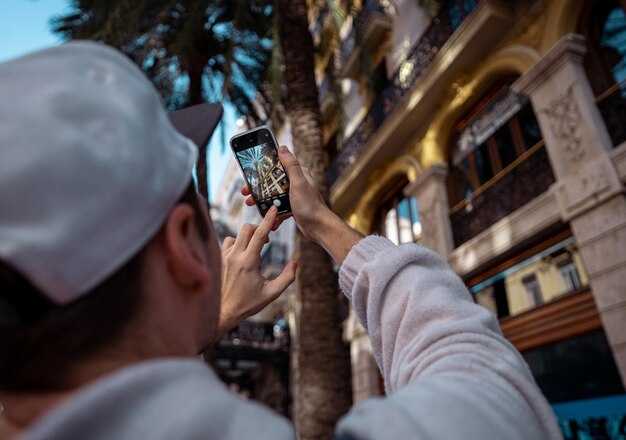Use Free Now, Bolt, and Citymapper as your core toolkit because they speed up pickups and help you compare fares in real time, delivering a smooth ride-hailing experience across Barcelona’s neighborhoods. When you book, you’ll see driver ETA in seconds and you can follow live driver updates directly in the map. Using these apps, you can readily switch between rides and transit without pulling out extra tickets, always staying prepared for every step of your arrival.
For a great start, use the TMB app ecosystem including Free Now, Cabify, Bolt, and the official transit app to cover taxis, ride-hailing, and metro trips. Each option shows status, with alerts for delays and disruptions. If you arrive by flight, set your pickup near the terminal and follow a route that blends tram or metro lines to minimize walking between transfers.
Plan with a few apps to maintain a level of control. In practice, Free Now often yields shorter waits than other options in Barcelona, while Citymapper helps you read transit history and predict busy windows with great accuracy. You’ll also see which routes generate the most alerts, so you can adjust on the go.
Smart habits boost ease: set your pickup point precisely, then touch the screen only to confirm. Avoid waiting by ordering a ride before you exit, and always monitor alerts about disruptions that might reroute you. What matters is keeping the flow smooth and staying on a predictable level of reliability, even during peak hours.
Keep a brief history of your rides; here is another quick check to ensure you’re using the fastest option in your area. This data helps you choose the right level of commitment to each platform on future trips, and you can read reviews to gauge reliability.
Which Apps Cover Barcelona Transit, Rides, and Walking Navigation
Citymapper is your primary pick for Barcelona transit, rides, and walking navigation. It combines real-time data for metro, tram, and bus with clear walking routes, time estimates, and pickups, helping you plan efficient maps around the city.
Google Maps offers broad transit coverage, ride-hailing options, and maps you can follow step by step. For walking, it guides pace and street-by-street directions and presents multiple route options, so you can compare and choose the main path that fits your plans.
Moovit concentrates on the main transit lines and service changes, with clear, marked stations and stops, plus wait times and route alternatives to keep you moving when schedules shift.
The official TMB App focuses on Barcelona’s system, offering timetable data for metro, buses, and trams, plus options to book tickets and check real-time disruptions. It’s a main source when you were unsure about local regulations and fare options.
Here WeGo and Maps.me deliver strong offline maps for when you lose signal. They let you download Barcelona city maps, plan routes offline, and then you can follow turn-by-turn directions down to street level. This is handy in crowded areas where you don’t want to hesitate about connectivity.
Rides services like Free Now and Cabify fill pickups when you need a ride between neighborhoods. You can book in advance or grab one on demand; compare priced options and choose the one that fits your budget and pace. Barcelona’s regulations sometimes limit ride-hailing windows, so check the app before you book.
Tips to maximize coverage: familiarize yourself with at least two apps, download offline maps for areas you’ll visit, and mark frequent stops on your maps. If you run into issues, try different ways, follow main routes, and avoid street-level detours. The possibilities are broad; pick Citymapper for transit, Google Maps for broad coverage, and a rides app for pickups when needed. If you were unsure, potentially switch apps to keep your route fluid, and don’t hesitate to switch if one app stalls.
How to Use Public Transit Apps for Metro, Bus, and Trains Without Getting Lost
lets you plan your trip with confidence: preload barcelonas centre routes in mapsme, mark your hotel, and save marked lines for metro, bus, and trains. mapsme shows your position, lets you compare options, and offers offline maps so you won’t get lost if data drops. also verify the live departures in the official transit app for safety of your trip.
Start with mapsme for maps and then switch to the licensed official app to see real-time departures, disruptions, and platform info. This lets you make a quicker choice when you need to switch lines. Thoughts on route options help you decide. If you prefer a cashless option, set up Apple Pay or a card in the app; many operators accept contactless on metro and buses, and you can spend less on single tickets by using t-casual or a similar multi-ride pass. Keep yourself organized by saving two backup routes so you’re ready for changes.
Regulations require tapping in and out on most services; the app will show when and where to validate your t-casual or other tickets. Make a plan before you go, especially for night trips, to avoid missed connections. What works for one day may not fit another; compare routes by time, transfers, and safety. The mapsme data helps you find alternative routes and even view nearby bikes when you want a multi-modal option.
Data privacy and value: choose licensed apps from reputable developers; disable unnecessary location sharing, and review data usage. The aim is value: you get faster routes, fewer delays, and less spend on tickets. In barcelonas centre, bus and metro lines connect your starting point to other districts quickly, and the combination of trains and buses offers a broader reach beyond your immediate area. Also keep an eye on regulations about bikes in the city; some streets require bike lanes and others ban certain vehicles in specific hours.
During your stay, let these tips guide you: mark your starting point and finish, plan a backup route, and use mapsme to keep a copy offline. night service often adds extra stops or changes timing; check the centre and barcelonas main corridors for better options. Another smart move: set a simple alert for delays, so you can switch to the quicker route without losing time. finally, know that the choice of apps is a business decision for travelers; use only licensed providers and always protect your data and personal information.
Costs, Data Usage, and Practical Tips for Popular Barcelona Navigation Apps

Start with offline maps for catalunya and the citys neighborhoods to control price and data usage on trips.
Cost snapshot and availability
- Google Maps: free for standard navigation; offline maps unlock a price-free option to navigate without data, while live traffic updates require data access. Availability is strong across all city areas and neighborhoods.
- Waze: free and easy-to-use for crowd-sourced traffic, with no subscription needed; data helps traffic accuracy, especially in peak hours.
- Citymapper: base navigation is free on many routes; platform offers optional Pro features at a modest price, useful for multi-modal trips across Barcelona.
- Maps.me (offline): free offline maps; excellent for data-free trips after download, including catalunya regions.
- Other platforms (Moovit, Apple Maps, etc.): most offer free core navigation with optional paid layers; choose based on which neighborhoods you visit most and the available transit data.
Data usage and footprint
- Online navigation with live traffic typically uses more data than offline mode; expect higher consumption during dense-city routing and frequent re-routes caused by congestion in traffic hotspots around la Barceloneta, Gothic Quarter, and Eixample.
- Offline maps require a one-time download; plan upfront for the availability of maps in areas you’ll visit, especially if you travel to outer zones or day trips.
- For regular city trips, lightweight queries (searches, place notes) add modest data usage; keep background data restrictions in place if you want to control consumption.
Real-world data usage expectations
- Online navigation with live traffic: roughly 5–15 MB per 30 minutes of active navigation, depending on route complexity and map detail.
- Offline maps: after download, navigation uses negligible data; the initial download size varies by region but Barcelona metro area typically falls in a few hundred megabytes per map pack.
- Transit planning and place lookups: small bursts of data, readily buffered by caches on most platforms.
Practical tips for a pleasant, authentic Barcelona experience
- Follow regulatory updates and area alerts in apps that surface transit disruptions; this helps you avoid crowded areas and keeps pace with changes in schedules.
- Use a single platform for a citywide overview and switch to offline maps when you know your trips will pass through areas with spotty reception.
- Plan multi-modal routes to balance time and comfort; combining metro, tram, and walking can cut traffic exposure and improve overall pace.
- For luggage management, download station-to-hac walking routes ahead of arrival; some apps offer luggage-friendly walking routes that avoid crowded corridors in peak hours.
- Explore neighborhoods with a focus on authentic experiences; use mapping tips to navigate citys corners like El Born, Gràcia, and Sant Antoni while staying aware of areas with narrow streets.
- Test easy-to-use, readily available offline options before a trip; this keeps you from relying on slow connectivity in busy quarters.
- When planning trips across catalunya and the Catalan coast, check availability of transit data in your app and keep a backup route in mind.
- Keep your device charged and carry a compact power bank; a smooth navigation experience reduces stress during dynamic city moves and helps you maintain a pleasant pace.
- If you travel with luggage, consider routes that minimize stair usage and transfers; some apps expose accessible alternatives that prioritize elevators and ramps in central hubs.
- Remember that most popular apps provide advantages like live ETA, step-by-step guidance, and alerts; pick the option that best fits your trips and readily adapts to changing conditions.
Top considerations by feature
- easy-to-use interfaces help you stay oriented while moving through busy neighborhoods.
- Choose which app to use based on availability of offline maps for the areas you’ll visit and the pace you prefer.
- Evaluate advantages of each platform for trips across Barcelona’s tram lines, metro, and buses.
- For citys trips beyond Barcelona, verify cross-border data access and any roaming charges to avoid surprises in price.
Uber in Barcelona: Where it Falls Short and Safe Alternatives to Consider

Skip Uber in Barcelona for most trips; instead use Cabify or Free Now for reliable access, and complement with Metro, tram, or bus for cheap, predictable costs. The interface of these services tends to be smoother, and fares are often lower during off-peak hours, especially along the coastal promenade from Barceloneta to the Olympic Port. If you’re planning a night out with family, this approach reduces gaps in taking rides and keeps things safer. If you want a wise start to your day, this setup gives you control over planning and less stress.
Uber coverage in Barcelona remains patchy around the Gothic Quarter and coastal hubs, with issues like sparse availability, long waits, or drivers left waiting or canceling when demand spikes. Despite the demand, this can force you to switch apps or walk, wasting time. Left with limited options, you may find it harder to keep your plans for excursions to the beach or museums on schedule. That’s why expert tips and a backup plan help you stay on track even if Uber falls short.
Safe alternatives to Uber include booking with Free Now or Cabify, which typically offer more consistent coverage and clear safety ratings; for quick coastal hops, rent a bike via bicing when eligible, or rent a city scooter if available; for longer trips or family outings, use the Metro or tram to stay on schedule; if you want a private ride, licensed taxis booked through an app provide familiar, reliable service. Planning with guruwalk tips and checking the local interface of each app helps you stay covered.
Practical tips: plan ahead with guruwalk or offline maps, compare fares before taking a ride, and opt for options with less costs and smoother transitions. For coastal strolls with family, mix bicing for short hops and metro for longer legs to keep mobility flexible while staying covered. If you want privacy, rentals for day trips around the hills and beaches can be cost-effective, but factor parking and fuel into your planning.



Comments